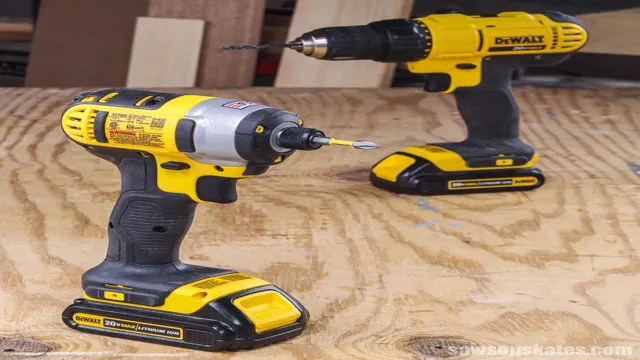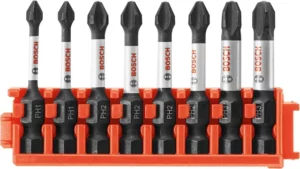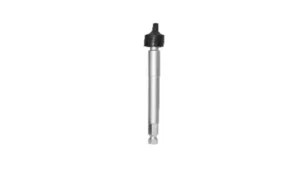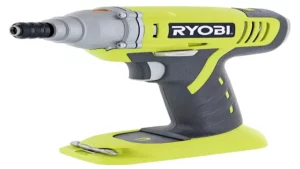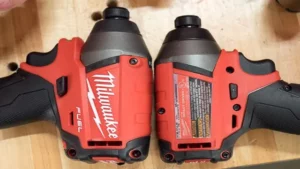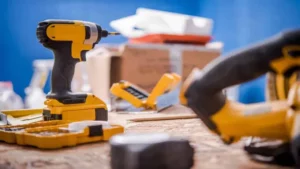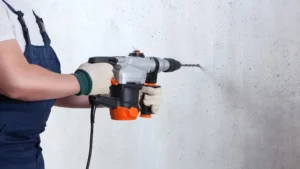Have you ever found yourself in a hardware store, staring at rows of drills and impact drivers, wondering if you need both or just one? It’s a common dilemma for DIY enthusiasts and professionals alike, and it can be confusing to know which tool is best suited for the job at hand. In this blog post, we’ll take a closer look at drills and impact drivers, discussing their differences, similarities, and advantages, so you can determine whether you need one, the other, or both in your workshop. Are you ready to become a power tool expert? Let’s get started.
Understanding the Difference
If you’re wondering whether you need an impact driver and drill, the answer is that it depends on the task at hand. While both tools are used for drilling and driving screws, they have some differences that may make one more suitable for certain jobs than the other. A drill is a versatile tool that can handle a wide variety of tasks, including drilling holes, driving screws, and mixing paint or mortar.
An impact driver, on the other hand, is designed specifically for driving screws and works by providing bursts of high torque to twist the screw into place. Impact drivers are particularly useful for driving longer screws and into harder materials. So, if you’re working on a job that involves a lot of driving screws into hard materials, an impact driver may be the better choice.
However, for more general tasks that involve drilling, driving screws into softer materials, or mixing substances, a drill may be more versatile.
Impact Driver
If you’re looking to invest in a power tool for your DIY projects, you may be confused about which one to choose: an impact driver or a drill? While they may look similar at first glance, they have some key differences. An impact driver is designed to do the hard work of driving screws and bolts into tough materials like wood and metal. It uses a combination of rotational force and concussive blows to create a powerful torque that can make even the most stubborn screw turn.
A drill, on the other hand, is better for drilling holes and screwing in smaller screws. It uses a smooth, steady rotation that is less likely to strip screws or damage delicate materials. So if you’re working on heavy-duty projects that involve lots of driving and fastening, an impact driver will be your best bet.
But if you need a versatile tool that can handle a range of tasks, a drill will be a better fit for you. So, before making a decision, think about the type of projects you’ll be working on and choose accordingly.
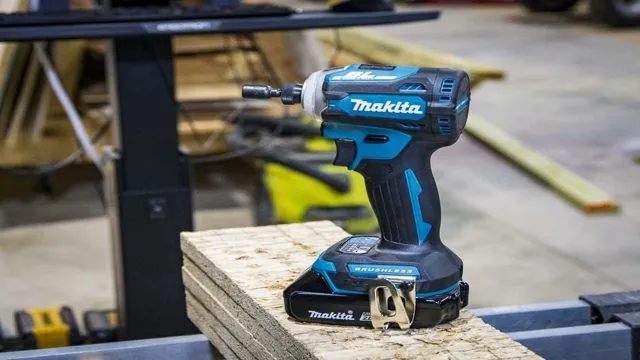
Drill
When it comes to drilling, there are a few key differences to keep in mind. Firstly, drilling refers to the process of creating holes in a surface using a drill bit. However, there are different types of drilling, including rotary drilling and percussion drilling.
Rotary drilling is the process of creating holes by rotating the drill bit, while percussion drilling involves a hammering action to break through the surface. Another difference to keep in mind is the type of drill bit being used. For example, a twist bit is a common type of drill bit used for drilling holes in wood or metal.
However, for masonry drilling, a masonry bit is needed, which is made of tungsten carbide and designed to handle the tough materials typically found in masonry surfaces. Overall, it’s important to understand these differences in order to use the right drilling technique and tools for your specific project needs.
When to Use an Impact Driver
If you’re wondering whether you need an impact driver and a drill, the answer depends on the type of tasks that you will be tackling. Impact drivers are best for tasks that require a lot of power and torque, such as driving long screws into dense materials like hardwood or metal. With an impact driver, you can quickly drive screws into the toughest of materials without struggling to keep the tool steady.
Drills, on the other hand, are best for drilling holes in materials like wood, plastic, or drywall. They’re also great for driving screws into softer materials where you don’t need as much torque. So, if you only plan on drilling and fastening in softer materials, a drill will suffice.
However, if you intend to work with harder materials, it’s best to invest in an impact driver as well. Ultimately, using both tools will make your work much easier and more efficient, allowing you to tackle any job that comes your way with ease.
Screwing and Fastening
An impact driver is a versatile and powerful tool that can come in handy for a variety of applications like screwing and fastening. Unlike a drill, an impact driver delivers a strong rotational force that makes it easier to work with different materials without the need for excessive pressure and torque. You can use an impact driver when working with lag bolts, decking screws, and long screws that require a bit of extra force to fasten.
Another benefit of using an impact driver is that it reduces the chances of stripping screws, which is a common issue when using a regular drill. It is important to note that an impact driver may not be suitable for more delicate tasks that require precision and control as it can be quite powerful. However, for larger projects, an impact driver is the perfect tool to have in your toolkit.
Tight Spaces
Using an impact driver can be a lifesaver when working in tight spaces. These powerful tools are designed to apply a high torque output with minimal effort from the user, making them ideal for driving screws and other fasteners into hard materials like metal and concrete. They are also great for working in tight spaces where a regular drill or screwdriver might be too bulky to maneuver.
An impact driver’s torque output allows it to apply more force to the fastener, resulting in a tighter grip and reducing the risk of stripped screws or bolts. If you find yourself working on a DIY project that requires you to drive screws into hard materials or in tight spaces, an impact driver can save you time and frustration. With its compact size and high torque output, you can work faster and with greater precision, ensuring the job is done right the first time.
Heavy-Duty Jobs
When it comes to heavy-duty jobs, you need a tool that can handle the task. That’s where the impact driver comes in. An impact driver is an excellent tool for heavy-duty jobs, especially when you need to screw or unscrew stubborn bolts or lag screws.
This tool is great to have in your toolbox if you work with wood, framing, or construction. One of the main advantages of using an impact driver is that it provides greater torque. The tool’s impact mechanism allows it to deliver more force than a traditional power drill, so you can easily drive a screw through even the hardest materials.
Additionally, the impact driver provides better control, making it easier to drive screws without stripping the head or damaging the wood. Another time to use an impact driver is when you’re working in tight spaces. The compact size of the tool allows you to get into corners and other hard-to-reach areas that a traditional drill cannot reach.
This feature is especially helpful if you’re working on a construction site or a home renovation project. In summary, if you’re working on a heavy-duty job that requires more torque and control than a traditional drill can provide, consider using an impact driver. With its powerful impact mechanism and compact size, this tool can make your work more efficient and effective.
So, add it to your toolbox and see how much easier your heavy-duty jobs will become.
When to Use a Drill
Many people often wonder if they need both an impact driver and a drill, or if one tool is enough for their projects. While both tools are designed for drilling holes and driving screws, they have different strengths and weaknesses. A drill is best suited for jobs that require precision and control, such as drilling small holes or driving screws into delicate materials like drywall or wood trim.
On the other hand, an impact driver is more powerful and better suited for heavy-duty tasks that require extra torque, such as driving long screws or bolts into tough materials like concrete or metal. So, if you’re working on a DIY project or a professional construction project, it’s important to assess your needs and choose the right tool for the job to ensure optimal results. In some cases, you may need both a drill and an impact driver to complete a project, while in others, one tool may suffice.
The key is to evaluate your needs and choose the right tool for the task at hand.
Drilling Holes
Drilling holes is a common task in many home improvement and DIY projects, but knowing when to use a drill is crucial. If you want to hang a picture frame, for example, you may not necessarily need to make a hole in the wall if you have adhesive strips. However, if you’re planning on mounting a TV or installing shelving, a drill will definitely come in handy.
Another important aspect to consider is the type of drill bit you’ll need for the project at hand. For softer materials like drywall, a standard twist bit will work fine, but for harder surfaces like concrete or tile, a masonry bit will be necessary. Remember to always wear safety goggles and be careful when using power tools!
Mixing Materials
Mixing different materials can be a tricky task, but sometimes it’s necessary to create a more durable or functional item. When it comes to joining different materials together, a drill can be a lifesaver. Drills are great for creating holes for screws or bolts to attach materials together.
They’re also handy when you need to create a joint between metal, wood, or plastic. However, it’s important to consider the specific materials you’re working with before drilling. For instance, some materials like glass or ceramic require special drill bits to prevent damage or cracking.
Additionally, when mixing materials, it’s important to consider the impact of expansion and contraction due to changing temperatures. A good rule of thumb is to always test a small area before committing to drilling the entire project. With the right tools and preparation, using a drill to mix materials can yield some impressive results that are both durable and functional.
Final Thoughts
If you’re someone who frequently tackles DIY projects around the house or workshop, you might have asked yourself whether you need both an impact driver and a drill. To put it simply, the answer depends on your specific needs and the type of projects you work on. While a drill is versatile and can handle a wide range of drilling and screwdriving tasks, an impact driver is designed to handle heavy-duty tasks, such as driving long screws and bolts into dense materials like hardwood.
So, if you find yourself regularly working with tougher materials, an impact driver might be a good investment. But if you’re mostly working on basic projects like hanging shelves or assembling furniture, a drill will likely suffice. Ultimately, it’s up to you to assess your needs and determine whether investing in an impact driver on top of a drill makes sense for your DIY toolkit.
Conclusion
In summary, the decision to purchase both an impact driver and drill ultimately depends on your needs and preferences. Are you only working with wood or are you tackling tougher materials like metal and masonry? Do you prefer a more compact and lightweight tool or one with more power and versatility? Whatever your answer may be, just remember: there’s no harm in having both in your tool collection. After all, it’s better to be prepared for any job that may come your way.
In the words of the wise handyman, ‘two tools in the hand are worth one in the shed.’ “
FAQs
What is the difference between an impact driver and a drill?
An impact driver is designed for tasks that require high torque and driving screws, while a drill is better suited for drilling holes and lighter tasks.
Can I use an impact driver for drilling holes?
While an impact driver can technically be used for drilling holes, it’s not recommended as it can be difficult to control the speed and depth of the hole.
Do I need both an impact driver and a drill?
It depends on the tasks you need to complete. If you frequently work with screws and need to apply high torque, an impact driver is a great addition. If you primarily need to drill holes, a drill is the better choice.
Can I use the same drill bits in an impact driver?
Yes, most drill bits are compatible with both drills and impact drivers.
What type of projects are ideal for an impact driver?
An impact driver is well-suited for tasks such as building decks and fences, assembling furniture, and driving long screws.
Should I choose a corded or cordless impact driver?
Cordless impact drivers offer more convenience and portability, while corded drivers provide more power and are better for heavy-duty tasks.
Are there any safety considerations when using an impact driver?
Yes, always wear eye protection and gloves when using an impact driver, and be sure to follow all safety instructions in the user manual.
